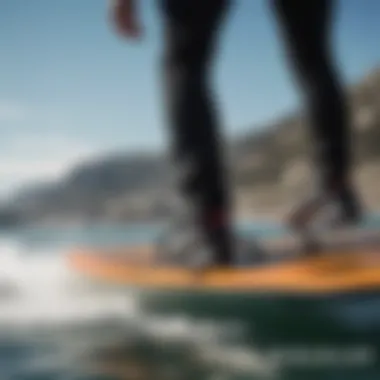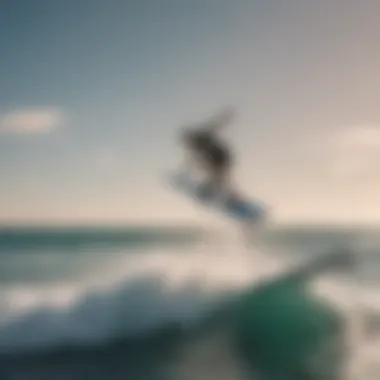Embarking on an Unforgettable Journey with Hydrofoil Boards


Equipment Rveeisws
Kitesurfing can be an exhilarating water sport, combining the thrill of the wind and waves with the skill and agility of the rider. Central to this sport is the equipment used, particularly the kites. When looking for the perfect kite, one must consider various factors such as size, shape, materials, and brand. Different kite models offer unique features and performance capabilities, making it essential for riders to choose wisely based on their riding style and preferences.
As for kiteboarding boards, riders have the option of twintip and directional boards. Twintip boards are popular for their versatility, allowing riders to perform freestyle tricks and maneuvers easily. On the other hand, directional boards are ideal for wave riding, providing better control in varying wave conditions. Understanding the design, construction, and riding style suitability of different boards is crucial for maximizing the kiteboarding experience.
When it comes to accessories, kiteboarders rely on a range of gear to enhance their performance and safety on the water. Essential accessories include harnesses, lines, pumps, and safety gear like helmets and impact vests. Each accessory plays a vital role in ensuring a smooth and secure kiteboarding session. Harnesses provide rider control and comfort, lines are essential for steering the kite, pumps inflate the kite efficiently, and safety gear protects against potential injuries. Understanding the importance of each accessory is key to a successful and safe kiteboarding experience.
Introduction to Hydrofoil Boards
The introduction to hydrofoil boards serves as a gateway to the captivating world of innovative water sports technology. Hydrofoil boards represent a paradigm shift in board design, elevating the riding experience to new heights. Understanding the intricacies of hydrofoil boards is essential for enthusiasts looking to delve into this exhilarating realm. This section unravels the core components, riding techniques, and safety measures that form the foundation of mastering hydrofoil boarding.
Definition and Concept
What Is a Hydrofoil Board?
Embarking on the journey of exploring hydrofoil boards necessitates grasping the essence of what a hydrofoil board truly entails. Essentially, a hydrofoil board is a surfboard or kiteboard integrated with a hydrofoil, a wing-like structure designed to lift the board above the water's surface. This innovation allows riders to glide effortlessly through the water, minimizing drag and enhancing speed. The allure of hydrofoil boards lies in their ability to unlock a surreal sensation of flying above the water, revolutionizing the conventional water sports experience.
The Principle Behind Hydrofoil Boards
Unveiling the intricate principle underpinning hydrofoil boards sheds light on the ingenuity driving this technological marvel. The essence of hydrofoil boards revolves around utilizing hydrodynamic forces to lift the board, minimizing contact with the water. By harnessing the principles of lift and drag, hydrofoil boards can achieve unparalleled efficiency and performance. Integrating this principle into board design enhances maneuverability, speed, and overall riding experience, positioning hydrofoil boards at the pinnacle of water sports innovation.
Evolution of Hydrofoil Technology
Early Developments in Hydrofoil Boards
Tracing the trajectory of hydrofoil technology unveils the early developments that laid the groundwork for contemporary designs. From rudimentary experiments to sophisticated prototypes, the evolution of hydrofoil boards showcases the perseverance and creativity of pioneers in the field. Early developments emphasized enhancing lift, stability, and control, setting the stage for the transformative advancements witnessed in modern hydrofoil designs.
Technological Advancements in Modern Hydrofoil Designs
The evolution of hydrofoil technology has witnessed a paradigm shift with the advent of modern design innovations. Technological advancements have revolutionized the materials, structures, and aerodynamics of hydrofoil boards, optimizing performance and functionality. Incorporating cutting-edge materials and advanced manufacturing techniques has elevated the efficiency, durability, and maneuvering capabilities of modern hydrofoil designs, propelling riders into a new realm of hydrofoil boarding excellence.
Mechanics of Hydrofoil Boards


In this segment of our exploration into the world of hydrofoil boards, we delve into the intricate details of the mechanics that drive these innovative water sports marvels. Understanding the mechanics of hydrofoil boards is paramount, as it not only influences performance but also ensures a safe and efficient riding experience. By comprehending the components, structures, and aerodynamics at play, riders can enhance their skills and maneuverability on the water.
Components and Structure
Understanding the parts of a hydrofoil board:
When it comes to hydrofoil boards, understanding the intricacies of their components is key to mastering their operation. From the wing to the fuselage, each part plays a crucial role in the hydrofoil's performance. The combination of these components dictates the board's stability, lift, and control in the water. Understanding how each piece interacts with the others provides riders with valuable insights into optimizing their hydrofoil experience.
The role of wings, mast, and fuselage:
The wings, mast, and fuselage collectively form the foundation of a hydrofoil board. The wings are responsible for generating lift, the mast ensures stability and depth control, while the fuselage connects these elements seamlessly. Each component's design, shape, and materials impact the board's aerodynamics and agility in the water. By comprehending the distinct functions of wings, mast, and fuselage, riders can fine-tune their equipment for peak performance.
Hydrodynamics and Lift
How hydrofoil boards generate lift:
The process of lift generation is fundamental to hydrofoil boarding. Understanding how hydrofoil boards harness lift through their wing design and hydrodynamic principles is essential for riders aiming to soar above the water's surface. By optimizing the shape, angle, and size of the wings, riders can achieve maximum lift with minimal drag, leading to smoother and more controlled rides.
The science of gliding above the water:
Gilding gracefully above the water is a hallmark of hydrofoil boarding. The science behind this phenomenon lies in the intricate balance between lift, speed, and rider control. By mastering the nuances of gliding above the water, riders can harness the full potential of their hydrofoil boards, executing seamless turns and maneuvers with precision and style.
Riding Techniques and Skills
Riding techniques and skills are pivotal components in mastering the art of hydrofoil boarding. As individuals delve into this exhilarating water sport, honing their skills becomes imperative for a seamless and enjoyable experience on the water. Each technique and skill contributes to the rider's ability to navigate the hydrofoil board with precision and grace. From balancing on the hydrofoil to executing intricate maneuvers, these skills elevate the rider's proficiency level, enabling them to explore the waters with confidence and finesse.
Learning to Ride a Hydrofoil Board
Balancing on the hydrofoil
Balancing on the hydrofoil is the essence of hydrofoil boarding. It entails maintaining stability and control while gliding above the water's surface. The key characteristic of balancing on the hydrofoil lies in the rider's ability to distribute their weight effectively to stay afloat. This skill is fundamental as it forms the foundation for all other maneuvers and tricks on the hydrofoil board. Mastering the art of balance grants riders the stability needed to progress to more advanced techniques seamlessly. However, achieving this balance requires practice and focus, as even slight shifts in weight can significantly impact the board's stability. Thus, developing a keen sense of balance is crucial for riders aiming to excel in hydrofoil boarding.
Initiating turns and maneuvers
Initiating turns and maneuvers play a vital role in a rider's ability to navigate the water tactfully. This aspect focuses on the techniques used to change direction and perform graceful movements on the hydrofoil board. The key characteristic of initiating turns and maneuvers lies in the rider's control over the board's movements through subtle shifts in weight and angle. By mastering this skill, riders can effortlessly glide through the water, exploring different trajectories and executing precise turns with ease. However, mastering turns and maneuvers requires patience and skill refinement, as each movement must be executed with precision to maintain control and fluidity. Therefore, honing this skill enhances a rider's ability to adapt to varying water conditions and challenges, elevating their overall performance on the hydrofoil board.


Advanced Maneuvers and Tricks
Mastering foiling transitions
Mastering foiling transitions is a hallmark of proficiency in hydrofoil boarding. This aspect involves seamlessly transitioning from the water to flying above the surface, showcasing the rider's finesse and control. The key characteristic of mastering foiling transitions lies in the rider's ability to harness the board's lift and adjust their body position for a smooth transition. This skill sets experienced riders apart, allowing them to glide effortlessly between different states, demonstrating precision and mastery of the hydrofoil board. However, mastering foiling transitions demands practice and a deep understanding of hydrodynamics, as riders must anticipate the board's behavior and react accordingly to achieve seamless transitions.
Exploring aerial tricks on a hydrofoil
Exploring aerial tricks on a hydrofoil introduces an element of creativity and innovation to the rider's repertoire. This aspect focuses on performing daring and acrobatic maneuvers while riding the hydrofoil board, pushing the boundaries of what is thought possible on the water. The key characteristic of exploring aerial tricks lies in the rider's ability to combine technical skill with courage and finesse, executing maneuvers that defy conventional expectations. By delving into aerial tricks, riders can carve their unique style and leave a lasting impact on the hydrofoil community. However, mastering aerial tricks requires determination and a willingness to push past one's comfort zone, as each trick demands precision, timing, and unwavering focus to execute flawlessly. Therefore, exploring these tricks not only showcases a rider's talent but also opens up a world of creative possibilities in hydrofoil boarding.
Choosing the Right Hydrofoil Equipment
When it comes to the exhilarating world of hydrofoil boards, selecting the appropriate equipment is paramount for a successful and enjoyable ride. The choice of hydrofoil equipment can significantly impact your performance on the water, making it crucial to understand the specific elements that make up a high-quality setup. By focusing on the right combination of components, riders can enhance their overall experience and maximize their potential on the hydrofoil.
Factors to Consider
Size and shape of the hydrofoil
The size and shape of the hydrofoil play a pivotal role in determining the characteristics of your ride. A larger surface area typically equates to more lift, allowing riders to launch out of the water effortlessly. On the contrary, smaller foils offer greater maneuverability and control, suitable for advanced users seeking precision in their movements. The shape of the foil also influences its hydrodynamics, affecting speed, stability, and responsiveness on the water. Understanding how the size and shape of the hydrofoil align with your riding style and skill level is essential for optimizing your performance.
Impact of wing configurations on performance
The design of the wings on a hydrofoil board has a direct impact on its performance capabilities. Different wing configurations, such as dihedral, anhedral, or cruciform shapes, impart varying levels of stability and control to the board. For instance, dihedral wings promote stability and ease of turning, making them well-suited for beginners looking for a forgiving ride. On the other hand, anhedral wings offer increased responsiveness and agility, perfect for adrenaline-seeking riders craving sharp turns and quick maneuvers. Understanding how wing configurations influence your riding experience is key to selecting the ideal setup for your needs.
Matching Boards and Foils
Compatibility between boards and foils
Ensuring compatibility between your board and foil is crucial for achieving optimal performance and safety. The dimensions of the board should complement the size and specs of the foil, creating a harmonious setup that enhances stability and control on the water. Mismatched boards and foils can lead to imbalanced rides, affecting maneuverability and overall responsiveness. By selecting components that work seamlessly together, riders can unlock the full potential of their hydrofoil setup and elevate their experience on the water.
Optimizing performance through equipment selection
The process of optimizing performance through strategic equipment selection involves identifying the unique characteristics of each component and tailoring them to your specific riding style. By choosing the right combination of board, foil, and accessories, riders can fine-tune their setup to amplify speed, agility, and overall performance. Selecting high-quality materials and technologies can further enhance the efficiency of your equipment, ensuring a smooth and exhilarating ride every time. Finding the perfect balance between components and functionalities is key to maximizing your hydrofoil experience and exploring the full potential of this futuristic water sport.


Safety Precautions and Guidelines
In the realm of hydrofoil boarding, safety precautions and guidelines play an integral role in ensuring a secure and enjoyable riding experience. Prioritizing safety is paramount to mitigate risks and potential dangers associated with this exhilarating water sport. By adhering to prescribed safety measures, riders can confidently explore the waters while minimizing the likelihood of accidents or injuries.
Understanding Risks and Challenges### Potential hazards of hydrofoil boarding
When delving into the domain of hydrofoil boarding, it is crucial to acknowledge the potential hazards that come with this high-speed water activity. From sharp foil components to collisions with underwater obstacles, riders face various risks that necessitate caution and vigilance. The unforgiving nature of hydrofoil boarding demands precise control and keen awareness to navigate through turbulent waters effectively. Recognizing these hazards allows riders to adopt a proactive approach towards risk management, thereby enhancing their safety on the water.
Preventive measures for a safe riding experience###
To circumvent the dangers associated with hydrofoil boarding, implementing preventive measures is imperative for safeguarding riders. Utilizing appropriate safety gear such as helmets, impact vests, and protective wetsuits can significantly mitigate the impact of falls or collisions. Additionally, acquiring proper training and familiarizing oneself with emergency protocols enhances preparedness in the face of unexpected circumstances. By exercising prudence and foresight, riders can elevate their safety standards and partake in hydrofoil boarding with assurance and peace of mind.
Emergency Protocols and Rescue Techniques### Dealing with equipment malfunctions
Dealing with equipment malfunctions is a critical aspect that riders must be well-versed in to handle unforeseen challenges effectively. In the event of technical issues or malfunctions mid-ride, maintaining composure and swiftly troubleshooting the problem is essential to prevent accidents or injuries. Familiarizing oneself with the workings of hydrofoil equipment and practicing response protocols can aid riders in addressing malfunctions promptly, ensuring a smooth and controlled continuation of their boarding session.
Assisting fellow riders in distress situations###
Collaborative support and swift assistance are fundamental elements of fostering a safe hydrofoil boarding community. When encountering fellow riders in distress or facing emergencies on the water, extending a helping hand and coordinating rescue efforts can be pivotal in averting potential crises. Building a sense of camaraderie and solidarity among riders cultivates a culture of mutual aid and ensures that all participants can engage in hydrofoil boarding activities with confidence and security.
In delving into the realm of hydrofoil boards, one cannot overlook the pivotal aspect of future trends and exploration. This section serves as a compass pointing towards the evolving landscape of hydrofoil technology. Understanding the trajectory of this innovation is essential for both enthusiasts and professionals alike. By exploring the nuances of future trends, individuals can stay ahead of the curve, adapting to the shifting currents of technology and design.
Diverse Applications of Hydrofoil Technology
Hydrofoil boards in surfing and kiteboarding
The integration of hydrofoil boards in surfing and kiteboarding signifies a revolutionary leap in water sports. The unique characteristic of hydrofoil boards lies in their ability to glide effortlessly above the water's surface, providing an unparalleled sense of freedom and speed. What makes hydrofoil boards particularly enticing is their capacity to elevate the rider's experience, offering a new dimension to traditional surfing and kiteboarding. A distinguishing feature of hydrofoil boards in surfing and kiteboarding is their enhanced maneuverability and reduced drag, resulting in a smoother and more dynamic ride. While the advantages of hydrofoil boards in these sports are numerous, such advancements do come with a learning curve that requires patience and dedication.
Innovative uses in water sports and marine industries
The application of hydrofoil technology in various water sports and marine industries opens up a realm of possibilities. From increased efficiency in cargo shipping to enhanced speed in naval vessels, the innovative uses of hydrofoils transcend the boundaries of traditional recreational activities. One key characteristic of innovative hydrofoil applications is their ability to revolutionize conventional modes of transportation on water. By incorporating hydrofoils into different contexts, industries can streamline operations, reduce energy consumption, and boost overall performance. However, it is crucial to consider the environmental impact of widespread hydrofoil use and ensure that advancements in technology are sustainable and responsible.
Advancements in Hydrofoil Designs
Integration of new materials and technologies
The fusion of new materials and technologies in hydrofoil designs marks a paradigm shift in the industry. By leveraging cutting-edge materials such as carbon fiber and aerospace-grade alloys, designers can achieve lightweight yet durable hydrofoils that enhance performance on the water. One key characteristic of this integration is the heightened strength-to-weight ratio, allowing for increased speed and agility during maneuvers. The unique feature of integrating new materials and technologies lies in the balance between structural integrity and flexibility, thereby optimizing the rider's experience while ensuring longevity and reliability.
Enhancing performance and efficiency through design innovations
Enhancing performance and efficiency through design innovations is at the forefront of hydrofoil evolution. By reimagining traditional design elements such as wing shapes and fuselage dynamics, engineers can fine-tune hydrofoil performance to meet the demands of extreme athletes and adrenaline enthusiasts. The key characteristic of these design innovations is their ability to push the boundaries of speed and control, enabling riders to execute intricate maneuvers with precision and style. One standout feature of enhancing performance through design innovations is the comprehensive approach to aerodynamics and hydrodynamics, optimizing lift and stability for an unparalleled riding experience.







